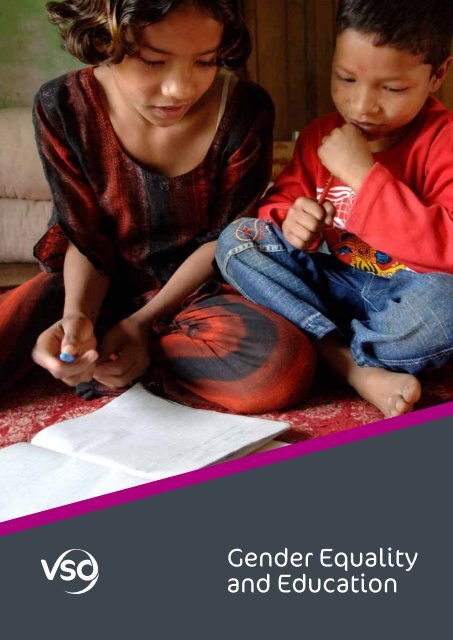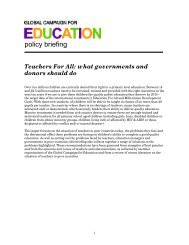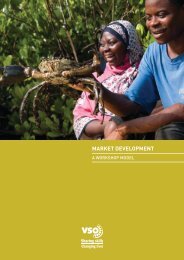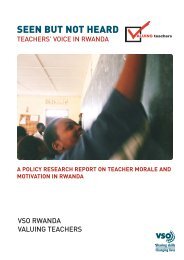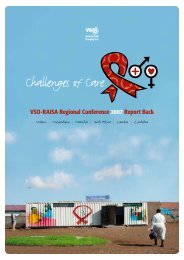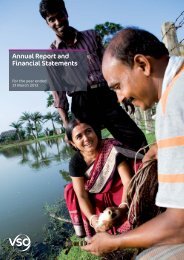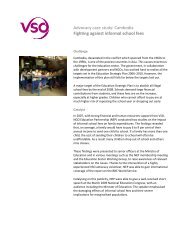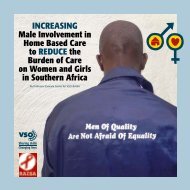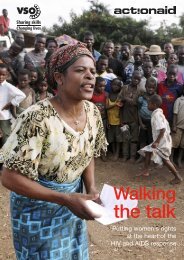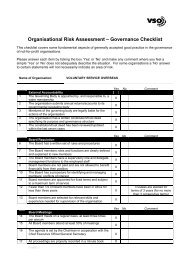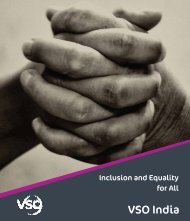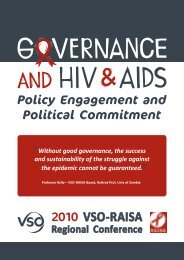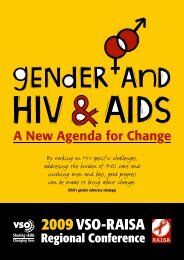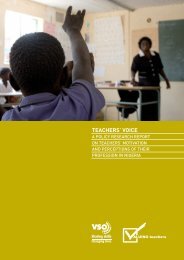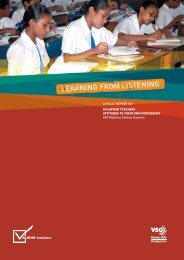VSO gender equality and education paper (448KB)
VSO gender equality and education paper (448KB)
VSO gender equality and education paper (448KB)
Create successful ePaper yourself
Turn your PDF publications into a flip-book with our unique Google optimized e-Paper software.
Gender Equality <strong>and</strong> EducationPage 1Gender Equality<strong>and</strong> Education
Gender Equality <strong>and</strong> EducationPage 2ContentsVso’s position on <strong>gender</strong> <strong>equality</strong> 1Gender <strong>equality</strong> <strong>and</strong> <strong>education</strong> 2Obstacles to <strong>gender</strong> <strong>equality</strong> in <strong>education</strong> 3Community level obstacles 3- Poverty <strong>and</strong> child labour 3- Socio-cultural constraints 4- Lack of parental involvement <strong>and</strong> community participation 5School <strong>and</strong> <strong>education</strong> system level obstacles 6- Lack of investment in quality <strong>education</strong> 6- Inappropriate attitudes, behaviours <strong>and</strong> skills of teachers 6- Lack of female or male teachers as role models 7- Lack of <strong>gender</strong>-friendly school environments 8Vso’s approach to <strong>gender</strong> <strong>equality</strong> in <strong>education</strong> 9- Addressing community level obstacles 9- Addressing school <strong>and</strong> <strong>education</strong> system level obstacles 11Recommendations - addressing <strong>gender</strong> <strong>equality</strong>in <strong>education</strong> 12
Gender Equality <strong>and</strong> EducationPage 1<strong>VSO</strong>’s position on <strong>gender</strong> <strong>equality</strong>For <strong>VSO</strong>, <strong>gender</strong> <strong>equality</strong> means that men <strong>and</strong> women have equal opportunities to realise their individualpotential – both to contribute to their country’s economic <strong>and</strong> social development <strong>and</strong> to benefit equallyfrom their participation in society. Gender in<strong>equality</strong> is based on <strong>gender</strong> biases <strong>and</strong> stereotypes in aparticular society. Even though <strong>gender</strong> <strong>equality</strong> refers to male <strong>and</strong> female concerns, the majority of <strong>gender</strong>imbalances in the developing world show a heavy bias against women. These biases <strong>and</strong> stereotypes canalso create problems for men, <strong>and</strong> create vulnerabilities for certain groups of people whose behaviours,identities <strong>and</strong>/or bodies do not fit the norm. They also constrain men <strong>and</strong> women from working effectivelytogether for the development of their society. In practical terms, this means a lower quality of life forwomen (e.g. more hours worked/less leisure, fewer <strong>education</strong>al opportunities, more violence, rape, lesspolitical representation,) <strong>and</strong> less income (e.g. less access to l<strong>and</strong> or credit, lower pay in the formal sector).<strong>VSO</strong> recognises that <strong>gender</strong> biases <strong>and</strong> stereotypes are a significant factor in the perpetuation of poverty,that they are socially acquired <strong>and</strong> not biologically determined; therefore they can <strong>and</strong> should bechallenged. <strong>VSO</strong> is committed to the achievement of <strong>gender</strong> <strong>equality</strong> <strong>and</strong> the promotion of the humanrights, which we believe is essential for sustainable development <strong>and</strong> social <strong>and</strong> economic justice.<strong>VSO</strong> also recognises that achieving <strong>gender</strong> <strong>equality</strong> means going further than improving female health <strong>and</strong><strong>education</strong>. It means, among other things, that women <strong>and</strong> men from all walks of life should be free to maketheir own choices, have access to decision making bodies <strong>and</strong> positions, the capability to exploit economicresources, <strong>and</strong> the opportunity to participate in society <strong>and</strong> politics.
Gender Equality <strong>and</strong> EducationPage 2Gender <strong>equality</strong> <strong>and</strong> <strong>education</strong>Millennium Development Goal 2: Achieve universal primary <strong>education</strong>Target 2A: Ensure that, by 2015, children everywhere, boys <strong>and</strong> girls alike, will be able to complete a fullcourse of primary schoolingGirls’ <strong>education</strong> has been a high priority for low income countries throughout the first decade of the 21 stcentury. A wide range of interventions - such as scholarships, stipends, conditional cash transfers, <strong>gender</strong>segregated toilets, recruitment <strong>and</strong> training of more female teachers - have all made a positive contributiontowards increasing the enrolment of girls into primary <strong>education</strong>.UN <strong>and</strong> civil society research has consistently argued that investment in girls’ <strong>education</strong> has significantbenefits for girls, women, their families, wider communities <strong>and</strong> societies:• An extra year of primary school boosts girls’ eventual wages by 10-20 per cent <strong>and</strong> an extra year ofsecondary school by 15-25 per cent 1 .• When women <strong>and</strong> girls earn income, they reinvest 90 per cent into their families, as compared to only30-40 per cent for a man 2 .• A girl in Africa who receives an <strong>education</strong> is three times less likely to contract HIV <strong>and</strong> AIDS 3 .• Education gives girls the confidence to marry later, <strong>and</strong> gives women greater influence in householddecisions. Educated women tend to have smaller families, their children are better nourished, morelikely to survive <strong>and</strong> are far more likely to do well at school themselves 4 .• Education also encourages active citizenship by giving girls <strong>and</strong> boys the knowledge to influence thedirection of society <strong>and</strong> to engage in politics <strong>and</strong> democracy as adults 5 .These examples illustrate how <strong>education</strong> generates cumulative social benefits for people, particularly girls<strong>and</strong> women. However, there are disparities in access to, <strong>and</strong> the quality of <strong>education</strong> enjoyed by learners<strong>and</strong> in learning outcomes among populations <strong>and</strong> groups due to social, economic <strong>and</strong> cultural factors. Sixtynine million primary school-aged children still do not attend school. In the majority of low income countriesgirls have less access to <strong>education</strong> than boys at all levels of <strong>education</strong>. Of the 759 million adults lackingliteracy skills today, two-thirds are women, a statistic that reflects the depth of <strong>gender</strong> disparity in access to<strong>education</strong> 6 . In sub-Saharan Africa alone, almost 12 million girls who are not attending school are expectednever to enrol while the number for boys is seven million 7 . According to UNESCO about half of the countriesin sub-Saharan Africa that have a Gender Parity Index (GPI) for primary enrolment in 2007 showed <strong>gender</strong>disparities favouring boys. Several countries in fact had a GPI below 0.85 (i.e. there were only 85 girls inenrolled for every 100 boys) – including Burkina Faso, Central African Republic, Chad, Côte d’Ivoire, Eritrea,Mali, Niger <strong>and</strong> Somalia 8 .1 Returns to Investmentin Education: A FurtherUpdate. Policy ResearchWorking Paper 2881,2002, World Bank2 Women’s Rights Vital forDeveloping World, 2003,Yale Daily News3 Back to School? TheWorst Places in theWorld to be a SchoolChild in 2010, 2010,Global Campaign forEducation4 A Fair Chance: Attaining<strong>gender</strong> <strong>equality</strong> in basic<strong>education</strong> by 2005, 2003,Global Campaign forEducation5 Gender <strong>and</strong> EducationFor All: The Leap toEquality. EFA GlobalMonitoring Report,2004, UNESCO6 Reaching theMarginalized. EFA GlobalMonitoring Report,2010, UNESCO7 Reaching theMarginalized: GenderOverview Paper forBeijing +15 Consultation,2010, UNESCO8 Sex-Disaggregated Data:a Brief Analysis of KeyEducation <strong>and</strong> ScienceIndicators Since theBeijing Declaration <strong>and</strong>Platform For Action(1995), 2010, UNESCOInstitute of Statistics9 The Mongolian Drop OutStudy, 2005, MongolianEducation Alliance10 Girls’ Education in the21st Century. GenderEquality, Empowerment<strong>and</strong> Economic Growth,2008, World Bank11 Thematic Paper on MDG3: Promote GenderEquality <strong>and</strong> EmpowerWomen, 2010, UNIFEMIt should be noted that <strong>gender</strong> in<strong>equality</strong> in <strong>education</strong> is not always about low enrolment <strong>and</strong> completion ratesof girls. In a small number of low income countries, girls enrolment <strong>and</strong> completion outstrips that of boys. Thismay happen where dem<strong>and</strong> for boys’ labour is higher. For example, poor rural families in Mongolia - particularlythose in highl<strong>and</strong> areas - often rely on boys to herd cattle, with the result that dropout rates are higher for boysthan girls 9 . For similar reasons, boys in Bangladesh are reportedly dropping out of school in much larger numbersthan girls, a phenomenon that is reported as being the country’s biggest <strong>gender</strong> challenge. Girls in Bangladeshnow account for 60 per cent of enrolments in some schools, especially in rural areas 10 .While fewer women than men have advanced to tertiary <strong>education</strong> in sub-Saharan Africa <strong>and</strong> South Asia,there are more women than men enrolled in tertiary <strong>education</strong> worldwide. Girls are much more likely toproceed to tertiary <strong>education</strong> in the Commonwealth of Independent States (former Soviet republics), LatinAmerica <strong>and</strong> the Caribbean, <strong>and</strong> South-East Asia. In developed regions there is now a reverse <strong>gender</strong> gap intertiary <strong>education</strong>: 129 females to 100 males 11 .The above examples indicate that context specific <strong>gender</strong> policy interventions are required to address <strong>gender</strong>in<strong>equality</strong> in <strong>education</strong>. Gender <strong>equality</strong> policies should include not only enrolment targets but also equalaccess to quality <strong>education</strong> <strong>and</strong> chances for completion of <strong>education</strong> at each level of the <strong>education</strong> system.
Gender Equality <strong>and</strong> EducationPage 312 Thematic <strong>paper</strong>son the MillenniumDevelopment Goals,2010, United NationsDevelopment Group13 Reaching theMarginalized. EFA GlobalMonitoring Report,2010, UNESCO14 Islam <strong>and</strong> the Educationof Women <strong>and</strong> Girls inthe Commonwealth,2008, CommonwealthSecretariat <strong>and</strong> Councilfor Education in theCommonwealth15 Accelerating actionagainst child labour:Global Report underthe follow-up to theILO Declaration onFundamental Principles<strong>and</strong> Rights at Work 2010,2010, InternationalLabour Organisation16 Convention on the Rightsof the Child, 1989, Officeof the United NationsHigh Commissioner forHuman Rights17 MillenniumDevelopment Goals:review of progress2010: MDG 2. Achieveuniversal primary<strong>education</strong> InformationBrief, 2010, InternationalLabour Office18 Ibid.19 Boys’ Underachievementin Education: anExploration in SelectedCommonwealthCountries, 2006,CommonwealthSecretariat <strong>and</strong>Commonwealth ofLearningObstacles to <strong>gender</strong> <strong>equality</strong>in <strong>education</strong>Underlying causes of <strong>gender</strong> in<strong>equality</strong> in <strong>education</strong> are diverse <strong>and</strong> interconnected; however, the followingare common causes that we have identified in countries where <strong>VSO</strong> works in <strong>education</strong>. These causes canbe broadly grouped into community level obstacles (those external to the school/<strong>education</strong> systemenvironment) <strong>and</strong> school <strong>and</strong> <strong>education</strong> system level obstacles (those internal to the school/<strong>education</strong>system environment).Community level obstaclesPoverty <strong>and</strong> child labourOne of the strongest <strong>and</strong> most influential factors contributing to <strong>education</strong>al marginalisation is householdpoverty as nearly 1.4 billion people live on less than US$1.25 a day 12 . Clearly, income poverty whencombined with low <strong>education</strong>al participation creates a cycle of exclusion from other rights such as access tohealth care, justice, a livelihood <strong>and</strong> political participation.Girls from excluded groups, such as children with disabilities or children from linguistic minorities, oftenencounter even greater obstacles in schools <strong>and</strong> classrooms – if their different learning needs or notconsidered, if classrooms are not accessible, or if lessons are delivered in a language they don’t underst<strong>and</strong>.Poorer parents are also more likely to withhold their children (girls or boys, depending on the countrycontext) from <strong>education</strong> so that they can work <strong>and</strong> contribute to household income or help with domestictasks. In Nigeria, for instance, 97 per cent of poor Hausa-speaking girls have fewer than two years of<strong>education</strong> 13 . The Commonwealth Secretariat has argued in a 2008 report that, for example, in some Islamicstates, poor parents especially, view formal <strong>education</strong> with suspicion <strong>and</strong> may believe it to be irrelevant forgirls. The report argues that the lack of <strong>education</strong>al infrastructure (schools that admit girls, or the lack ofbasic facilities such as <strong>gender</strong> segregated toilets) in such countries tends to exacerbate such beliefs 14 .The International Labour Organisation (ILO)’s most recent estimate 15 suggests that there are still 215 millionchildren involved in child labour, violating the internationally agreed human rights st<strong>and</strong>ards laid out in theUnited Nations Convention on the Rights of the Child 16 . The ILO reports that, if not all, the majority childrenworldwide missing out on primary <strong>education</strong> are child labourers 17 . Governments will clearly need toaccelerate their efforts to eliminate child labour since the two things are inextricably linked.“Education is a key element in the prevention of child labour, while child labour is oneof the main obstacles to Education For All. Children who need to work full time cannotgo to school” 18In most low income countries girls have to work to support their families financially (especially those fromsingle-parent families) <strong>and</strong> have increased responsibility for domestic chores in the home. Poverty has agreater impact on girls than on boys since families from poorer rural backgrounds tend to prioritise theirsons over their daughters’ <strong>education</strong>. The nature of <strong>gender</strong> related <strong>education</strong>al participation is of coursehighly context specific. Whether boys or girls are underachieving in <strong>education</strong> in any particular country,region or community, will depend on the prevailing concepts of masculinity <strong>and</strong> femininity, <strong>and</strong> on whetherthe society or community is predominantly patriarchal or matriarchal. Case studies from Jamaica, Samoa<strong>and</strong> Lesotho collected by the Commonwealth Secretariat 19 , highlight examples of different <strong>gender</strong> normswhich lead to underachievement among boys compared to girls. Anecdotal evidence from <strong>VSO</strong>’s ownprogramme experience from Guyana, Mongolia <strong>and</strong> The Philippines reminds us that we have to be carefulto avoid global generalisations when talking about <strong>gender</strong> in<strong>equality</strong> in <strong>education</strong> systems.
Gender Equality <strong>and</strong> EducationPage 4The impact of poverty on girls’ <strong>education</strong> cambodiaIn Cambodia many children, especially girls, are required to work in order to supplement the meagreincomes of poor families. An estimated 52 per cent of 7 to 14 year-olds (over 1.4 million children inabsolute terms) in Cambodia are economically active 20 . To these children <strong>and</strong> their families living inextreme poverty, an <strong>education</strong>, with its long-term returns, has little economic value as long as there aregreater, more immediate monetary gains from each member contributing to the family earnings at as earlyan age as possible.“It is not a lack of underst<strong>and</strong>ing of the value of <strong>education</strong> but the realisticunderst<strong>and</strong>ing of the present job situation that influences parents to make thechoice to keep their children at home. Many parents believe that children shouldattend school up to Grade 3 to acquire sufficient knowledge for ‘reading things atthe market, medicine labels <strong>and</strong> their own children’s homework’ after which theywould be better off learning relevant life skills at home <strong>and</strong> contributing to familyincome <strong>and</strong> thriving at locally available jobs” 21Education inequalities across income groups <strong>and</strong> <strong>gender</strong> are enormous. In countries where girls are themost disadvantaged in terms of participation in <strong>education</strong>, girls from the poorest households <strong>and</strong> ruralareas, ethnic or linguistic minorities are even more disadvantaged. Such <strong>education</strong> differentials by incomeare intensified by <strong>gender</strong> in<strong>equality</strong> in low-income countries. For example: Cambodia, Ethiopia <strong>and</strong> Ghanaall have laws <strong>and</strong> constitutions enshrining the right to free primary <strong>education</strong> <strong>and</strong> they have all introducedpolicies to eliminate user fees for primary <strong>education</strong>, which has resulted in increased in enrolment.However, while formal charges were eliminated, informal costs have remained a barrier. A research reportundertaken with the assistance of a <strong>VSO</strong> volunteer for the NGO Education Partnership in Cambodia in2007 22 found that parents were spending over US$100 a year to send one child to school – which amountedto 8.7 per cent of reported annual family income. Despite formal fees being officially illegal, other costsassociated with taking children to school included start up costs for school uniforms, study materials <strong>and</strong>school registration, daily costs for food <strong>and</strong> transport, occasional fees for lesson h<strong>and</strong>outs <strong>and</strong> exam <strong>paper</strong>s,<strong>and</strong> for class supplies, bike maintenance, gifts for teachers <strong>and</strong> ceremonies <strong>and</strong> optional fees for privatetutoring. Despite the abolishment of formal school fees, many parents therefore continue to cite theirinability to afford these informal costs as the reason their children; particularly girls <strong>and</strong> children withdisabilities do not attend school.20 Teaching in Cambodia,2008, HumanDevelopment SectorEast Asia <strong>and</strong> the PacificRegion The WorldBank <strong>and</strong> Ministry ofEducation, Youth <strong>and</strong>Sport Royal Governmentof Cambodia21 Why Children drop outof Primary School, 2006,<strong>VSO</strong> Cambodia22 The Impact Of InformalSchool Fees On FamilyExpenditure, 2007, NGOEducation Partnership23 Pregnant Teens ForcedOut of School, 2010,Inter Press Service24 The UK Government’sDepartment forInternationalDevelopment25 Canadian InternationalDevelopment Agency –Canada’s lead agency fordevelopment assistance26 Cameroon, Ethiopia,Ghana, Guyana,Namibia, Nigeria,Rw<strong>and</strong>a, Tanzania <strong>and</strong>the Thai-Burma borderprogramme27 <strong>VSO</strong> BaselineInformation Report,2008, <strong>VSO</strong> International(unpublished)Socio-cultural constraintsThe effects of poverty are strongly conditioned by social attitudes, cultural <strong>and</strong> religious factors. In manysocieties, girls are expected to get married at an early age. For instance, in Tanzania, according to theMinistry of Education statistics, 28,600 girls left school between 2004 <strong>and</strong> 2008 because they becamepregnant. At secondary level in 2007 one in five girls fell pregnant <strong>and</strong> did not finish school 23 . Traditional<strong>and</strong> cultural beliefs in patriarchal communities or societies clearly reinforce <strong>gender</strong> biases <strong>and</strong> stereotypesthat give preference to boys over girls in access to <strong>education</strong> <strong>and</strong> assert that girls should remain in thehome. This prevents girls from attending, remaining <strong>and</strong> performing in school particularly at the upperprimary <strong>and</strong> secondary levels when they take on more responsibilities including caring for younger siblings<strong>and</strong> older relations.In 2008 <strong>VSO</strong> conducted a baseline report for DFID 24 <strong>and</strong> CIDA 25 reporting, on the capacity of our partners topromote <strong>gender</strong> <strong>equality</strong> <strong>and</strong> the quality of <strong>education</strong> experienced by girls across a total of nine developingcountries 26 . In one focus group in Ethiopia all but one girl had lost a parent or was caring for a sick familymember <strong>and</strong> been forced to give up school in order to work. One girl said:“My father is sick <strong>and</strong> bed bound. When I see my friends going to school in uniform,I do also like to go to school <strong>and</strong> I know how important <strong>education</strong> is for your future.But if I go to school, my mother could not work” 27
Gender Equality <strong>and</strong> EducationPage 528 Ibid.29 Liberating Girls from‘Trokosi’: CampaignAgainst Ritual Servitudein Ghana, 2001, UNIFEM30 What is FGC?, 2010, TheOrchid Project31 Female genitalmutilation Fact sheetN°241, 2010, WorldHealth Organisation32 Putting Children at theCentre of Education:How <strong>VSO</strong> supportspractice <strong>and</strong> Policy inPrimary Schools, 2008,<strong>VSO</strong> Ethiopia33 Why 60 Million GirlsStill Aren’t in School <strong>and</strong>What to do About it,2006, Centre for GlobalDevelopmentTeachers in a focus group discussion in Ghana highlighted the vicious cycle many girls find themselves in,where time spent on domestic chores leads to low performance in school which in turn feeds into parents’low expectations of their daughters, often leading to drop-out. Teachers said that:“Girls are made to do household chores, unlike boys. This takes away some time forstudies on the part of the girl child <strong>and</strong> as a result her performance in school is below par<strong>and</strong> her grades are low. The parents see this as a loss in their investment with the hopethat the girl should look after them later. The girl is therefore taken out of school” 28In addition to girls’ roles as caregivers <strong>and</strong> housekeepers, there are many other socio-cultural beliefs <strong>and</strong>practices which negatively impact on girls’ <strong>education</strong>; for example, puberty rites <strong>and</strong> Trokosi (female ritualslavery) in Ghana, <strong>and</strong> female genital cutting (FGC) in many African countries. Trokosi is a practice prevalentin Ghana’s Volta region in which girls accused of crimes or violations of social norms, are punished by beingsent by their families into servitude as a form of penance. Girls are expected to serve local priest for threeto five years, after which the family might redeem her. During this time, girls are forced to drop out ofschool. The practice reportedly results in repeated sexual abuse <strong>and</strong> unwanted pregnancies which makereturn to school even more difficult 29 .FGC is a culturally-entrenched puberty rite of passage that involves the cutting or removal of a girl’s externalgenitals. Sometimes the hood of the clitoris is removed; in other cases the entire clitoris <strong>and</strong> labia are cut.‘Infibulation’ is the most severe form, where the wound is sewn up leaving only a tiny opening, through whichgirls urinate <strong>and</strong> menstruate. The hard scar tissue that forms becomes a physical barrier to penetrative sex <strong>and</strong>to giving birth. On their wedding nights <strong>and</strong> just prior to labour, girls are cut open <strong>and</strong> are then re-sewn 30 . TheWorld Health Organisation estimates that between 100 <strong>and</strong> 140 million girls <strong>and</strong> women worldwide have beensubjected to FGC 31 , with the practice being most prevalent in the western, eastern <strong>and</strong> north-eastern regionsof Africa, <strong>and</strong> some countries in Asia <strong>and</strong> the Middle East. FGC is practiced often on girls as young as 12 or 13,who usually then drop out of school to marry <strong>and</strong> start a family.Lack of parental involvement <strong>and</strong> community participationWhere cultural practices such as the above are prevalent, clearly there will be an impact on parents’perceptions of their daughters’ abilities. Parents in countries where the dominant <strong>gender</strong> biases <strong>and</strong>stereotypes favour boys may perceive that girls have limited job opportunities in the formal sector, whichthey consider as the most important return on their investment in <strong>education</strong>. They may believe that boysoften have greater aspirations <strong>and</strong> opportunities than girls. However, evidence from an external evaluationconducted by <strong>VSO</strong> Ethiopia suggests that girls often have just as high aspirations as boys <strong>and</strong> as solid anunderst<strong>and</strong>ing about the opportunities open to them if they succeed in <strong>education</strong>. As one grade eight(upper primary school) girl, from Dawdo School, in Amhara, Ethiopia put it:“I would like to become a lawyer to protect women from all kinds of abuse. We need tosafeguard their rights” 32Increased parental engagement in their children’s <strong>education</strong> has been shown many times over to contributesignificantly to children’s learning. Parental involvement includes engaging parents <strong>and</strong> communities in thegovernance of schools as well as encouraging parents to create a supportive learning environment for theirchildren at home in which they can study 33 . Involving parents also helps assure them that their daughtersare safe at school. However, lack of access to <strong>education</strong>al information at the community level, means thatparents lack knowledge <strong>and</strong> underst<strong>and</strong>ing of school management structures. Furthermore, members ofschool management committees <strong>and</strong> of parent teacher associations are not clear about the roles they couldplay <strong>and</strong> how they could engage with relevant district structures <strong>and</strong> <strong>education</strong> authorities.
Gender Equality <strong>and</strong> EducationPage 6School <strong>and</strong> <strong>education</strong> system level obstaclesLack of investment in quality <strong>education</strong><strong>VSO</strong>’s experience from our programmes suggests that after abolishing user fees, increasing investments inother inputs to maintain <strong>and</strong> improve the quality of <strong>education</strong> is vital. As the example from Cambodia, onpage four, shows, without simultaneous investment in teacher preparation, recruitment, sufficientremuneration <strong>and</strong> continuing professional development for teachers, <strong>and</strong> the provision of free schoolmeals, transport, textbooks, teaching <strong>and</strong> learning materials, uniforms, <strong>and</strong> improved infrastructure,policies that abolish user fees will do little to improve the overall quality of <strong>education</strong>.Parents, teachers <strong>and</strong> girls interviewed by <strong>VSO</strong> for our baseline report all agreed that basic inputs such ashuman <strong>and</strong> material resources, infrastructure <strong>and</strong> facilities <strong>and</strong> sufficient instructional time, are necessaryfor effective learning to take place 34 . Low quality inputs to schools <strong>and</strong> perceptions of the irrelevance ofschool further reduce the willingness of parents to send their children to school 35 .34 <strong>VSO</strong> BaselineInformation Report,2008, <strong>VSO</strong> International(unpublished)35 <strong>VSO</strong> BaselineInformation Report,2008, <strong>VSO</strong> International(unpublished)36 Teacher Professionalismin Punjab: RaisingTeachers’ Voices, 2005,<strong>VSO</strong> Pakistan37 <strong>VSO</strong> BaselineInformation Report,2008, <strong>VSO</strong> International(unpublished)Inappropriate attitudes, behaviours <strong>and</strong> skills of teachersThe quality of <strong>education</strong> delivery is strongly influenced by the attitude, behaviour <strong>and</strong> skills of teachers inthe schools. Specifically <strong>gender</strong> sensitive <strong>and</strong> inclusive teaching has a direct impact on pupils’ participation<strong>and</strong> performance in the classroom, particularly for girls in patriarchal societies (or equally for boys inmatriarchal societies). In the absence of <strong>gender</strong> friendly teaching skills, teachers may not encourage <strong>and</strong>respect the participation <strong>and</strong> contribution of girls (or of boys, where boy underachievement is the mainproblem). Gender biases <strong>and</strong> stereotypes expressed by pupils, teachers, parents <strong>and</strong> community members<strong>and</strong> corresponding discriminatory practices are left unchallenged, thus reinforcing <strong>and</strong> reproducing <strong>gender</strong>inequalities. In most schools involved in <strong>VSO</strong>’s baseline report, teachers were reported as beingdiscriminatory towards girls. One focus group of girls in Ghana reported that:“We [girls] are expected to behave in a culturally appropriate manner, to performcertain tasks that society assigns to us <strong>and</strong> be obedient. Our teachers often ask us toclean classrooms <strong>and</strong> offices, fetch water for the school <strong>and</strong> sometimes undertaketasks for teachers e.g. prepare food” 36The research was found that teachers (both male <strong>and</strong> female) who had not had any <strong>gender</strong> sensitivitytraining <strong>and</strong>/or training on inclusive <strong>education</strong> often considered girls to be less intelligent than boys. Manyhead teachers, school directors, members of school management committees <strong>and</strong> parents also held thisview. The reasons given for this perception were that girls’ performance in the school was often lower thanthat of boys <strong>and</strong> that they did not participate actively in the classroom. Teachers reported that girls wereoften weak at English, Maths <strong>and</strong> Science compared to boys <strong>and</strong> also less regular in the class.Although there was generally recognition of heavier work burdens on girls, teachers did not always link thisfactor with their poor performance. There was a strong tendency to blame the girls’ background <strong>and</strong> lay theresponsibility at the feet of the parents. Without training in <strong>gender</strong> sensitive <strong>and</strong> inclusive teaching <strong>and</strong>learning methodologies teachers had difficulty identifying strategies for supporting low achieving pupils.Limited instructional time <strong>and</strong> teacher absenteeism was cited by girls who dropped out of school, as acontributory factor in their parents’ decision for not continuing their <strong>education</strong>. However the manylegitimate reasons for absenteeism such as personal illness (including HIV <strong>and</strong> AIDS); caring for sick relatives(especially true in countries with high HIV prevalence rates); attending funerals; undertaking training; <strong>and</strong>the requirement for teacher to assist in local government activities; <strong>and</strong> the extremely low salaries – whichoften require teachers to take on second jobs or engage in subsistence farming to survive <strong>and</strong> feed theirfamilies – should be acknowledged. <strong>VSO</strong> research in Pakistan, for example, has found that teacher absence– especially among female teachers – is worse in rural areas, where there is greater physical insecurity,harassment <strong>and</strong> poor sanitary facilities in schools, which significantly hamper the teachers’ ability toperform effectively. Female teachers discussed transport difficulties <strong>and</strong> the fact of commuting from urbanareas with unknown men in buses as reasons for absenteeism 37 .
Gender Equality <strong>and</strong> EducationPage 738 Ibid.39 Teachers in AnglophoneAfrica. Issues in TeacherSupply, Training <strong>and</strong>Management, 2009,World Bank40 Gender <strong>and</strong> EducationFor All: The Leap toEquality. EFA GlobalMonitoring Report,2004, UNESCO41 Women’s Education inDeveloping Countries :Barriers, Benefits <strong>and</strong>Policies, 1993, WorldBank42 No male teachers inquarter of primaryschools, 2010, TheTelegraph43 Is menstrual hygienea management anissue for adolescentschoolgirls? 2009, WaterAidLack of female or male teachers as role modelsThe lack of female teacher role-models was also highlighted (by community level stakeholders interviewedby <strong>VSO</strong>, in the countries involved in the baseline report) as being a key factor in hindering girls’ experienceof quality <strong>education</strong> 38 . They told us that female teachers serve as role models for girls’ participation in<strong>education</strong>. Their presence encourages parents to send their children to school, both because they seeopportunities for their daughters outside the household <strong>and</strong> because of the increased sense of security forgirls when female teachers are present. The girls interviewed for the report confirmed this view stating thatthey would be more comfortable to talk to a female teacher about the challenges they face when theyreach puberty 39 .However the shortage or complete absence of female teachers in rural schools, in many countries, isalarming. For example, In Ug<strong>and</strong>a <strong>and</strong> Zambia, the share of female teachers in urban primary schools isabout 60 per cent, compared with 15 per cent to 35 per cent in rural areas 40 . This <strong>gender</strong> imbalance in theteaching workforce has been proven to have negative consequences on the improvement of <strong>gender</strong><strong>equality</strong> in schools. It also has a significant impact on the retention of girls in schools as girls are less likelyto progress to higher levels of schooling if their personal needs for coaching <strong>and</strong> counseling are not met dueto the absence of female teachers at lower secondary <strong>and</strong> secondary levels. Some parents are unwilling tosend their girls to schools where they know there are only male teachers <strong>and</strong> that chances of sexual abuse<strong>and</strong> violence are higher.However, according to UNESCO, girls’ enrolments rises relative to boys’ as the proportion of female teachersrises from low levels 41 . And the relationship between female teachers’ presence <strong>and</strong> girls’ attainment <strong>and</strong>achievement at school is important because well-trained female teachers can easily spot girls’ that are atrisk of dropping out prematurely <strong>and</strong> take steps to address the problem before it is too late 42 .Conversely in some countries, a shortage of male primary teachers creates different problems for boys. Forinstance, almost three-in-10 primary schools in Engl<strong>and</strong> are now staffed entirely by women. Male teachersmake up just 12 per cent of the primary school workforce resulting in concerns that a lack of male role modelsmay be putting boys off school at a young age <strong>and</strong> promoting the view that hard work is for girls. Girlscurrently outperform boys at the age of seven <strong>and</strong> pull ahead throughout primary <strong>and</strong> secondary school 43 .Evidently, whether the problem is lack of female role models for girls or lack of male role models for boysthe remedy is to ensure that the teaching force becomes <strong>gender</strong> balanced <strong>and</strong> should not be dominated byeither <strong>gender</strong>. This will require specific policy responses to encourage more women (or more men) to trainas teachers. Some of these are outlined in the recommendations section of this policy briefing, but contextspecific solutions will evidently have to be determined based on the nature <strong>and</strong> extent of <strong>gender</strong> in<strong>equality</strong>in each country <strong>and</strong> on the challenges specific to urban, rural <strong>and</strong> remote areas, linguistic minorities, ormigrant, refugee or other minority communities.
Gender Equality <strong>and</strong> EducationPage 8Lack of <strong>gender</strong>-friendly school environmentsHead teachers <strong>and</strong> school directors we interviewed for our baseline report, reported the many challengesthey were facing to establish even basic physical facilities such as safe drinking water, sufficient classrooms<strong>and</strong> furniture, <strong>and</strong> basic sanitary facilities – including separate toilets for girls <strong>and</strong> boys). And yet the strongcorrelation between girls reaching puberty <strong>and</strong> absenteeism from school, has been often been highlightedin the literature. A survey of adolescent school girls conducted by Water Aid in Nepal, for example, showedthat about half of the respondents (53 per cent) had been absent from school at least once due tomenstruation. Lack of privacy for cleaning <strong>and</strong> washing (41 per cent) was the major reason identified bysurvey respondents for being absent during menstruation. This is usually due to issues such as lack ofrunning water or missing door locks, even when a working toilet is present 44 .The issue of insecurity for girls <strong>and</strong> female teachers on the way to school <strong>and</strong> in school – due to <strong>gender</strong>based violence, e.g. sexual abuse, forced prostitution or other forms of sexual exploitation <strong>and</strong> traffickingwas also raised in the discussions conducted during <strong>VSO</strong>’s Valuing Teachers research 45 , where femaleteachers reported concerns with regard to safety in housing particularly in rural areas. Sexual harassment atschool level is a common issue reported by both female teachers <strong>and</strong> girls in the research. For example:• In Mozambique one participant spoke of a boarding school where as many as 40 per cent of the girls wholived in the boarding house became pregnant, <strong>and</strong> of the authorities’ lack of interest in solving what theydid not regard as a problem, simply a cultural phenomenon. Research participants reported that teacherswho are found guilty of rape or sexual harassment/abuse are generally transferred to another post, withno other sanction or legal action taken (such as dismissal or imprisonment) 46 .• In The Gambia teachers posted away from their families in isolated positions reported the addeddifficulty of dealing with sexual harassment <strong>and</strong> inappropriate conduct. Coupled with family duties <strong>and</strong>responsibilities, this makes remote postings an even more difficult for female teachers 47 .• In Ethiopia teachers highlighted that women <strong>and</strong> girls were the ‘victims of harmful traditions’, such asforced marriage, abduction, sexual assault <strong>and</strong> rape, while male students have been known to beat <strong>and</strong>insult female teachers <strong>and</strong> pupils 48 .Sexual harassment <strong>and</strong> improper sexual relations with girls by teachers was an issue for focus groups of girlsin <strong>and</strong> out of school <strong>and</strong> for focus groups with parents in Ghana, Cameroon, Ethiopia <strong>and</strong> Namibia,conducted for the <strong>VSO</strong> baseline report 49 . And of course sexual harassment is not confined to abuse of girlsby male teachers. In Afghanistan, although a highly patriarchal society, because men are taught that womenare unclean <strong>and</strong> are discouraged from even looking at women or girls, it is boys that are the subject ofsexual harassment. The story hit the headlines in 2010 when the US State Department called it a“widespread, culturally sanctioned form of male rape” 50 . Whilst there is little research available the extentof sexual harassment of boys by male teachers in Madrassas (koranic schools), internet reports imply thatthe practice is widespread in both Afghanistan <strong>and</strong> Pakistan 50 .44 <strong>VSO</strong> has conductedresearch on teachers’motivation <strong>and</strong> moralein 14 countries45 Listening to Teachers,2008, <strong>VSO</strong> Mozambique46 Teachers Speak Out,2007, <strong>VSO</strong> The Gambia47 How much is a goodteacher worth? 2009,<strong>VSO</strong> Ethiopia48 <strong>VSO</strong> BaselineInformation Report,2008, <strong>VSO</strong> International(unpublished)49 Afghanistan’s dirtylittle secret, 2010, SanFrancisco Chronicle50 ‘Mullahs SexuallyAggress or Rape theirYoung Students in theMadrassas, the KoranicSchools’, 2006, BruceTefft
Gender Equality <strong>and</strong> EducationPage 9Vso’s approach to <strong>gender</strong> <strong>equality</strong>in <strong>education</strong>Promoting <strong>gender</strong> <strong>equality</strong> is one of <strong>VSO</strong>’s development priorities in all its country programmes as acrosscutting theme. Supporting the provision of girls’ <strong>education</strong> is a central focus in many of <strong>VSO</strong>’sEducation Programmes as in most of the countries where it is girls that are more excluded than boys. Oneof our key strategies for increasing our impact in <strong>education</strong> is to work through multiple interventions atmultiple levels of the <strong>education</strong> system, from the school <strong>and</strong> local community to national level policy. Webelieve that if we really are going to improve the quality of <strong>education</strong> for girls <strong>and</strong> boys in any given schoolthen we need a combination of interventions in overlapping strategic areas to achieve this quality. Forexample at district level in Ghana we have: volunteers training teachers to use <strong>gender</strong>-sensitive teachingstrategies in the classroom; increased support for training, recruitment <strong>and</strong> deployment of femalesteachers; alongside sensitisation of parents on the value of <strong>education</strong> for their daughters. Theseinterventions relate to our key areas of work in <strong>education</strong> on the ground: ‘teaching <strong>and</strong> learning’, ‘<strong>education</strong>management’ <strong>and</strong> community engagement’ <strong>and</strong> are reinforced <strong>and</strong> showcased through our regional <strong>and</strong>national level policy <strong>and</strong> advocacy work in support of girls’ <strong>education</strong> (see diagram below).Policy <strong>and</strong> advocacyTeaching<strong>and</strong> LearningQualityEducationEducationManagementCommunityEngagementAddressing community level obstacles<strong>VSO</strong> has many approaches to addressing community level obstacles to girls’ <strong>education</strong> in partnership withgovernment <strong>and</strong> non-government organisations; some examples are:• Building the capacity of Parent Teachers Associations (PTAs) <strong>and</strong> Community Based Organisation (CBOs)to support their school communities more effectively through meaningful participation in schoolmanagement <strong>and</strong> collaboration with local <strong>education</strong> authorities to address issues affecting the access <strong>and</strong>quality of <strong>education</strong>• Organising activities to sensitise parents on the value of <strong>education</strong> for their children, both boys <strong>and</strong> girls,with a specific focus on inclusion <strong>and</strong> identification of the most excluded children in a particular community• Community <strong>and</strong> national level advocacy initiatives to strengthen the capacity of civil society coalitions atdistrict, provincial <strong>and</strong> national levels to undertake participatory advocacy research <strong>and</strong> use the evidencegathered to influence policy making <strong>and</strong> implementation at different levels of the system• Working to analyse <strong>and</strong> address socio-cultural barriers by working with Parent Teachers Associations,School Management Committees, village chiefs, youth groups <strong>and</strong> other opinion leaders in communitiesto identify <strong>and</strong> find locally appropriate ways to dismantle obstacles that prevent girls <strong>and</strong> children withdisabilities from going to <strong>and</strong> remaining in school• Linking parents of girls to income-generating opportunities to increase their incomes to enable themmaintain their girls in school• Providing support for adult literacy in order to promote the importance of <strong>education</strong> <strong>and</strong> support forgirls’ schooling.
Gender Equality <strong>and</strong> EducationPage 10Improving girls’ <strong>education</strong> in Northern Ghana <strong>and</strong> CameroonIn both Ghana <strong>and</strong> Cameroon Parent Teacher Associations, School Councils <strong>and</strong> Mothers Groups havebeen collaborating with Education authorities to address some of the issues that affect girls’ enrolment,retention <strong>and</strong> performance in school.In Cameroon, <strong>VSO</strong> has built the capacity of 30 Mother Teacher Associations <strong>and</strong> 39 School Councils inthe regions where girl’s <strong>education</strong> has been identified as an issue. <strong>VSO</strong> has worked alongside UNICEFCameroon as co-creators of the initiative with the full collaboration of the Government. <strong>VSO</strong> volunteerswork directly with Schools Inspectors as supervisors of their activities in their respective schools <strong>and</strong>with RECAMEF, a <strong>VSO</strong> partner, which is the network of Mothers Teachers Associations (MTAs), to raiseawareness about MTAs. <strong>VSO</strong> volunteers are placed in schools clusters as School Development Advisors.They work closely with school committees in pairs with national volunteers to facilitate capacity buildingof the committees as well as of individual members. As a result of activities such as adult literacy classes<strong>and</strong> <strong>gender</strong> sensitisation for parents, awareness raising of teachers on <strong>gender</strong> sensitive <strong>and</strong> inclusiveclassroom management through focus group discussions there have been the following outcomes:• PTAs, MTAs <strong>and</strong> school committees have an increased underst<strong>and</strong>ing of their roles <strong>and</strong> responsibilities;this has led to a reactivation of school committees in 46 schools• The school communities are more aware or the work of the committees which are working better <strong>and</strong>managing resources adequately through the use of accountable documents <strong>and</strong> procedures• Collaboration between teachers <strong>and</strong> the community has improved with teachers engaging more oftenin awareness <strong>and</strong> fund raising activities to support the communities’ involvement• Collaboration amongst government representatives, local councils <strong>and</strong> school committees in 57 schoolsis progressing well with regular interaction <strong>and</strong> involvement in decision-making in school projects• Parents’ underst<strong>and</strong>ing of about the importance of <strong>and</strong> value <strong>education</strong> has increased dramatically• In the far north of Cameroon the number of children enrolled in schools where <strong>VSO</strong> is building thecapacity of PTAs has risen by almost 14 per cent (since the baseline was carried out in 2008), <strong>and</strong> thenumbers of children out of school has dropped by nearly 20 per cent.In Ghana the Nadowli Assembly Women’s Advocacy Group (NAWAG), an elected group of DistrictAssembly women, has been supported by <strong>VSO</strong> volunteers to work together more strategically, to sourceexternal funding, advocate <strong>and</strong> lobby the council to improve services that negatively impact on girls, forthe past four years. While the assembly women were achieving successes as individuals they were doinglittle to support each other. So the Community Advocacy Volunteer worked with the women to helpthem underst<strong>and</strong> how they could work together to support <strong>and</strong> advise each other <strong>and</strong> learn from theirindividual experiences to increase the group’s impact <strong>and</strong> effectiveness. Some outcomes have been:• The dormant Area Councils have been ‘woken up’. School Management Committees <strong>and</strong> PTAs who arenow working collectively to support girls’ <strong>education</strong>. Alerting Head Teachers, Teachers, CircuitSupervisors, Girl Child Officers <strong>and</strong> the community to work together more effectively.• More communities now appreciate women in leadership, <strong>and</strong> now more women in the communitywant to take up leadership roles.• There is increased community cohesion <strong>and</strong> enthusiasm for addressing <strong>education</strong> issues. Men are nowmore willing to listen to <strong>and</strong> be led by women (this also strengthens husb<strong>and</strong>-wife relationships <strong>and</strong>decision making in the home).• Retention <strong>and</strong> safety of girls in school has improved as NAWAG has successfully lobbied for theprovision of boreholes in Owllo community to enable girls to spend less time fetching water enablingthem to improve their attendance at school.• NAWAG also advocates for girls who are sexually abused <strong>and</strong> supports them to return to school.• NAWAG has secured funding from Barclays, MTN (a mobile phone company) <strong>and</strong> support from local<strong>education</strong> <strong>and</strong> community stakeholders to develop <strong>and</strong> implement The GREAT Project (Girls RetentionEnrolment <strong>and</strong> Transition Project). This Project will enable the Assembly women to address poorretention rates in school by providing the most deprived children with resources such as uniforms,books <strong>and</strong> bags, helping schools improve décor <strong>and</strong> resources <strong>and</strong> improving the availability ofmentoring <strong>and</strong> school club activities.• In Nadowli district in Ghana the number of children enrolled in schools in communities supported byNAWAG has risen from by 31.9 per cent (since the baseline was carried out in 2008), <strong>and</strong> the numbersof children out of school has dropped by 70.6 per cent.
Gender Equality <strong>and</strong> EducationPage 11Addressing school <strong>and</strong> <strong>education</strong> system level obstaclesOur approach to school <strong>and</strong> <strong>education</strong> system level obstacles is multi-faceted <strong>and</strong> looks at both issues affectingteaching <strong>and</strong> learning <strong>and</strong> <strong>education</strong> management at all levels of the <strong>education</strong> system, some examples are:• delivering training on <strong>gender</strong> friendly teaching material production <strong>and</strong> providing materials to increasegirls’ performance• supporting government Continuing Professional Development initiatives to improve teacher skill,attitude <strong>and</strong> behaviour <strong>and</strong> provide in-service training programmes on <strong>gender</strong> related issues <strong>and</strong><strong>gender</strong> perspectives in teaching for schoolteachers, <strong>gender</strong>- focal persons <strong>and</strong> supervisors• strengthening girls <strong>and</strong> boys clubs to increase their knowledge on <strong>gender</strong>, sexuality, HIV <strong>and</strong> AIDS,career development skills to become more confident <strong>and</strong> assertive <strong>and</strong> providing them with smallgrants to improve school facilities, such as latrines (for girls <strong>and</strong> boys) <strong>and</strong> water• training District <strong>and</strong> Regional <strong>gender</strong> officers to provide continued support to the teachers <strong>and</strong> headteachers, monitor reports <strong>and</strong> feedback on lessons to the national level• strengthening <strong>gender</strong> mainstreaming in curricula <strong>and</strong> textbook revision <strong>and</strong> development• increasing the number of teachers, particularly female teachers, at all levels of <strong>education</strong>, who are welltrained <strong>and</strong> supported to provide quality <strong>education</strong> for girls <strong>and</strong> enrich their school experience throughteacher training support <strong>and</strong> national level advocacy on teacher recruitment policies• support the process of local, provincial <strong>and</strong>/or national policy formulation <strong>and</strong> implementationframeworks to be more <strong>gender</strong> sensitive.Improving academic performance for female student teachers EthiopiaSignificant changes have been observed in female students’ enrolment at all levels of the <strong>education</strong> system inEthiopia. Yet, the female attrition rate is still high especially when it comes to the tertiary levels of <strong>education</strong>.With the support of <strong>VSO</strong>, Haramaya University has tried to address the problem. The University established <strong>and</strong>strengthened a Gender Office so as to offer different services for female students in the University, for example:• training for newly admitted female students on assertiveness <strong>and</strong> study skills• establishment of a ‘Gender Awareness, Leadership <strong>and</strong> Club Management for Girls’ Union <strong>and</strong> Forum’• training in <strong>gender</strong> sensitive leadership skills for female students <strong>and</strong> staff at the School of Graduate Studies• provision of guidance <strong>and</strong> consultation services for all female students• economic support for needy students• tutorial support for newly-admitted female students as well as students with poor performance.For students who have been dismissed as a result of poor academic performance, a pilot project was initiatedby the Office of the Academic Vice President <strong>and</strong> put into practice by involving the Gender Office, theDepartments of Mathematics <strong>and</strong> English, English Language Improvement Centre <strong>and</strong> Registrar’s Office. Thewhole program was led by the Academic Vice President <strong>and</strong> coordinated by Gender Office. The programstarted after selecting 257 academically dismissed first-year female students in collaboration with the Officeof the Registrar. Text materials were prepared especially for the program so as to improve the students’numeracy, communication, listening <strong>and</strong> grammar skills. Students’ progress was evaluated based on frequenttests, class participation <strong>and</strong> attendance <strong>and</strong> final exams were held. The students were awarded automaticreadmission based on the recommendations made by their instructors. In addition to English classesdelivered by staff in the Department of English Language, the English Language Improvement centre offeredEnglish support to students supported by the <strong>VSO</strong> co-ordinator. The sessions aimed to give students thechance to improve their communication skills. Improvements, especially in speaking, general underst<strong>and</strong>ingof spoken English <strong>and</strong> overall confidence were observed by the <strong>VSO</strong> volunteer.The Gender Office evaluated the overall program <strong>and</strong> found that it had had multiple academic, social<strong>and</strong> economic outcomes for the students, including:• Enabling the students to revise, gain knowledge <strong>and</strong> improve their underst<strong>and</strong>ing of the subjects.• Supporting academically dismissed students to avoid involvement in risky life styles. Academicallydismissed female students tend to remain in the surrounding cities rather than going back home totheir families. Consequently, many female students begin to work as housemaid or commercial sexworkers <strong>and</strong> are more vulnerable to unwanted <strong>and</strong> unplanned marriage.
Gender Equality <strong>and</strong> EducationPage 12Recommendations - addressing<strong>gender</strong> <strong>equality</strong> in <strong>education</strong>The following recommendations have been divided according to the community <strong>and</strong> school <strong>and</strong><strong>education</strong> system level obstacles explored previously, <strong>and</strong> include recommendations for governments,donors (both rich country donor agencies <strong>and</strong> international non governmental organisations) <strong>and</strong>national, provincial <strong>and</strong> community level civil society organisation.51 Convention on the Rightsof the Child, 1989, Officeof the United NationsHigh Commissioner forHuman Rights52 Child Protection SystemsIn Emergencies: ADiscussion Paper, 2010,Save the Children53 Missing an EducationThe Big Book, 2004,Global Campaign forEducationCommunity level obstacles to <strong>gender</strong> <strong>equality</strong> in <strong>education</strong>• Governments should develop <strong>and</strong> implement a holistic approach to address obstacle to <strong>gender</strong> <strong>equality</strong>in <strong>education</strong>. Focusing on what happens only in the school or classroom is not enough, for example greatercollaboration <strong>and</strong> participation between <strong>education</strong> authorities, civil society <strong>and</strong> communities is needed toaddress obstacles to <strong>gender</strong> <strong>equality</strong> in <strong>education</strong> (whether it is girls or boys that are most disadvantaged).• Community based organisations should support communities to analyse, plan <strong>and</strong> implement theirown solutions to address obstacles to <strong>gender</strong> <strong>equality</strong> in <strong>education</strong>. For example through workingwith Parent Teacher Associations to better underst<strong>and</strong> the issues in their communities <strong>and</strong> developappropriate interventions to address them.• Zero tolerance campaigns about violence against girls <strong>and</strong>/or boys should be developed. Governments,donors <strong>and</strong> civil society organisations should join h<strong>and</strong>s to campaign jointly (at local, provincial <strong>and</strong>national, levels) for <strong>and</strong> to ensure perpetrators of <strong>gender</strong> based violence are brought to justice. Civilsociety organisations should use international human rights frameworks such as the Convention on theRights of the Child 51 <strong>and</strong> mechanisms such as local child protection committees 52 to address school orcommunity based violence <strong>and</strong> child abuse• Awareness of the inequalities exacerbated by traditional <strong>gender</strong> roles should be debated nationally.Governments, donors <strong>and</strong> civil society should work with parents <strong>and</strong> communities to instigate nationaldebates on radio, television, news<strong>paper</strong>s <strong>and</strong> new media to challenge <strong>and</strong> transform attitudes regardingtraditional <strong>gender</strong> roles for girls, boys, women <strong>and</strong> men – such as household chores, early marriage, caregiversin the home <strong>and</strong> explore alternative approaches <strong>and</strong> ways of ending harmful traditional practices(such as female genital cutting), prejudicial attitudes <strong>and</strong> discriminatory practices.• Parents need to be convinced of the potential <strong>and</strong> value of <strong>education</strong> for girls (or boys where theyare disadvantaged). Governments, donors <strong>and</strong> civil society should raise awareness by asking key femalerole-models in society who have achieved high professional or celebrity status to speak out publicly <strong>and</strong>regularly on the value of <strong>education</strong> for girls. Similar male role models could be asked to speak out incountries where boys under achievement is the problem.• Financial support to enable families to send their children should be increased especially for girls toschools from poor <strong>and</strong> rural households. For example through ensuring that government scholarshipor stipend schemes are properly implemented at local level or communities <strong>and</strong> families are linked toincome-generating activities• Campaigns to end child labour should be strengthened. Governments, donors <strong>and</strong> civil society shouldwork collaboratively to ensure all children – girls <strong>and</strong> boys - can go to school wherever they live <strong>and</strong>whatever their household income. Conditional financial support to income poor households will go someway to addressing this, but other approaches such community led campaigns using simple techniques like‘missing out maps’ 53 can also be used to determine which girls or boys are missing from school <strong>and</strong> why(whether they are employed in domestic, agricultural or other firms of child labour).
Gender Equality <strong>and</strong> EducationPage 1354 Sustainable Strategies toEnd Conference ReportViolence Against Girls inSchools, 2006, Action Aid<strong>and</strong> the Open Society55 IbidSchool <strong>and</strong> <strong>education</strong> system level obstacles to <strong>gender</strong> <strong>equality</strong>in <strong>education</strong>• Adequate resources should be allocated on time to District Education Offices <strong>and</strong> Schools. Particularly inremote <strong>and</strong> rural areas, <strong>and</strong> particularly as enrolment rates increase. Both financial <strong>and</strong> human resourcesshould be deployed according to need. As enrolment rates increase this presents an unprecedentedopportunity to address <strong>gender</strong> imbalances in the teaching staff of individual schools.• Donors <strong>and</strong> INGOs should support governments to implement <strong>gender</strong>-sensitive teacher training as partof the pre-service curriculum as well as part of continuing professional development. Pre-service <strong>and</strong>in-service training curricula need to be aligned so that both newly qualified teachers <strong>and</strong> teachers withmany years of service are trained in <strong>gender</strong> sensitive teaching methodologies.• Head-teachers <strong>and</strong> College Principals should be empowered to address <strong>gender</strong>-based violence, sexualharassment <strong>and</strong> other inappropriate behaviours of teachers in schools <strong>and</strong> colleges. It needs to beaddressed seriously <strong>and</strong> perpetrators of violence or abusers of girls or boys should be brought to justice.• Governments should support all schools <strong>and</strong> colleges to develop <strong>and</strong> implement sexual harassment policies<strong>and</strong> to develop alternative approaches to discipline to corporal punishment. Learning from other countriesabout strategies to address violence against girls in schools should be accessed <strong>and</strong> lessons learned 54 .• Local governments must ensure that <strong>gender</strong> issues are considered as part of all school planningprocesses. In particular clean <strong>and</strong> safe segregated toilets <strong>and</strong> washrooms must be provided <strong>and</strong>monitored to enable regular attendance of girls <strong>and</strong> female teachers.• Civil society organisations should engage in campaigning at international <strong>and</strong> national levels on childrights issues such as sexual harassment <strong>and</strong> corporal punishment in schools. Lessons learnt fromstrategies <strong>and</strong> campaigns should be shared <strong>and</strong> employed in other countries 55 .• Donors should support governments to increase training, recruitment <strong>and</strong> deployment of femaleteachers where they are scarce (similar efforts should be made to train <strong>and</strong> deploy more male teacherswhere they are scarce). Since teachers <strong>and</strong> other <strong>education</strong> workers act as powerful role models for girls,where there is a noticeable lack of female role models in schools, governments should:- improve incentives, living <strong>and</strong> working conditions for female teachers, including making adequate <strong>and</strong>equal arrangements for maternity <strong>and</strong> paternity leave (so that the burden of care for children fallsequally on fathers <strong>and</strong> mothers)- prohibit discrimination against women, in teacher <strong>and</strong> <strong>education</strong> management recruitment, posting <strong>and</strong>promotion systems- set <strong>and</strong> monitor national goals or quotas for hiring women <strong>and</strong> be flexible with age <strong>and</strong> <strong>education</strong>requirements for women (while providing compensatory in-service training).- invest in recruitment campaigns that encourage women to break with powerful social norms <strong>and</strong> adoptteaching careers- allow head teachers to control teacher recruitment for their schools, to enable them to balance thenumber of male <strong>and</strong> female teachers- implement measures such as ensuring accommodation for female teachers is safe, particularly in ruralareas where active recruitment <strong>and</strong> training of women from the local area may be necessary- improve the quality of Education Management Information Systems (EMIS) to enable teacher or publicservice commissions to make more informed decisions about teacher deployment to address <strong>gender</strong>imbalances in schools.
<strong>VSO</strong> is a federation of member organisationsthat all contribute volunteers <strong>and</strong> resourcesfrom Canada, India, Irel<strong>and</strong>, Kenya, theNetherl<strong>and</strong>s, the Philippines <strong>and</strong> the UK tofight poverty in more than 40 developingcountries. <strong>VSO</strong> has <strong>education</strong> programmes in15 countries. Volunteers supportimprovements in <strong>education</strong> by working inteacher training colleges <strong>and</strong> with schools ondeveloping teaching methods. They also workwithin the mainstream <strong>education</strong> system toovercome the barriers to marginalised groups,for example, by improving policies relating toteachers <strong>and</strong> <strong>education</strong> informationmanagement systems <strong>and</strong> the provision ofinclusive <strong>education</strong> in partnership with local<strong>and</strong> national government in areas such asassessment, strategic planning, nationalcurriculum development, monitoring <strong>and</strong>evaluation, <strong>and</strong> national quality st<strong>and</strong>ards.<strong>VSO</strong> also undertakes national level advocacyresearch through its Valuing Teacherscampaign <strong>and</strong> is an active member of theGlobal Campaign for Education, aninternational coalition of charities, civil societyorganisations <strong>and</strong> <strong>education</strong> unions thatmobilises public pressure on governments toprovide the free <strong>education</strong> for all childrenwhich they promised to deliver in 2000. Since2000, <strong>VSO</strong>’s Valuing Teachers research hasbeen conducted in 14 countries <strong>and</strong> iscurrently underway in three further countries.Following the research, advocacy strategies aredeveloped, which include the development ofvolunteer placements in civil society <strong>education</strong>coalitions <strong>and</strong> <strong>education</strong> ministries.In addition to this publication, the following research may also be of interest,available from the <strong>VSO</strong> International website:www.vsointernational.org/valuingteachers• How Much is a Good Teacher Worth? A report of the motivation <strong>and</strong> morale ofteachers in Ethiopia (2009)• Leading Learning: a report on effective school leadership <strong>and</strong> quality <strong>education</strong> inZanzibar (2010)• Learning From Listening: a policy report on Maldivian teachers’ attitudes to theirown profession (2005)• Lessons from the Classroom: teachers’ motivation <strong>and</strong> perceptions in Nepal (2005)• Listening to Teachers: the motivation <strong>and</strong> morale of <strong>education</strong> workers inMozambique (2008)• Making Teachers Count: a policy research report on Guyanese teachers’ attitudes totheir own profession (2004)• Managing Teachers: the centrality of teacher management to quality <strong>education</strong>.Lessons from developing countries (2008)• Qualifying for Quality- unqualified teacher <strong>and</strong> unqualified teacher shortages in TheGambia (2011)• Seen But Not Heard: teachers’ voice in Rw<strong>and</strong>a (2004)• Teachers for All: what governments <strong>and</strong> donors should do (2006)• Teachers Speak Out: a policy research report on teachers’ motivation in TheGambia (2007)• Teachers Talking: contributions of primary teachers to the quality of <strong>education</strong> inMozambique (2011)• Teachers’ Voice: A policy research report on teachers’ motivation <strong>and</strong>perceptions of their profession in Nigeria (2007)• Teaching Matters: a policy report on the motivation <strong>and</strong> morale of teachers inCambodia (2008)• Valuing School Leaders: an investigation into the constraints facing school leaders inThe Maldives (2009)<strong>VSO</strong>Carlton House27a Carlton DriveLondon SW15 2BSTel: +44 (0) 20 8780 7500Fax: +44 (0)20 8780 7300www.vsointernational.orgFor more information please contact:advocacy@vso.org.uk<strong>VSO</strong> is a charity registered in Engl<strong>and</strong> <strong>and</strong>Wales (313757) <strong>and</strong> in Scotl<strong>and</strong> (SCO39117).Photo credit: © Annie BungerothPublished 2011


